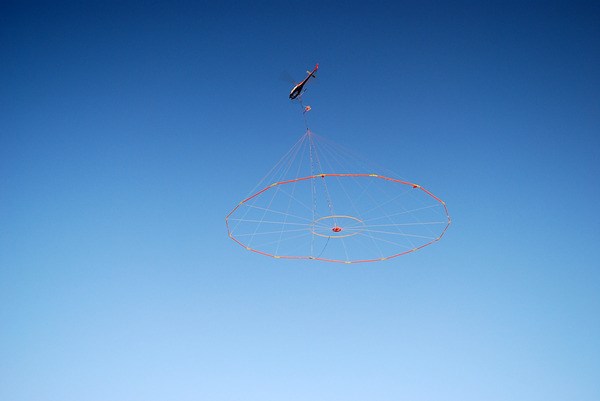Most folks in Snow Lake have seen it flying over and around the community, and those unlikely few who haven't, have no doubt spotted the chopper in the Diamond Willow parking lot, or its low-slung spider web payload situated in the Sunset Bay Park. That cargo is known in the mining exploration business as Geotech's 'Mega' VTEM (versatile time-domain electromagnetic helicopter borne).
Geotech Airborne Geophysical Surveys is an Aurora Ont.-based company that has been flying electromagnetic surveys around Snow Lake for several years now. There are a number of area exploration companies that have contracted them, and within the camp they have flown the conventional VTEM, as well as the new ZTEM, and now 'Mega' VTEM, which is the latest and the most powerful VTEM system developed by Geotech Ltd.
With its 35-mm diameter transmitter loop, 'Mega' VTEM looks like a massive dream catcher slung below the helicopter. And capture dreams it can. The 'Mega' VTEM system can detect conductive geological zones such as copper-zinc sulphide mineralized rock to depths from 500 to 600 metres, or even deeper depending on the geological characteristics of the survey region.
While working out of its base in Snow Lake, the system was contracted to survey two local claim blocks in the Rod/Osborne area owned by Jiminex Inc., the "Parres" and "Parres Two" properties. In an early February news release, Jiminex explained the work and cost saving benefits of the technology. "The accurate positioning of anomalies detected by this system means that ground follow-up line cutting and geophysical surveys are not required, resulting in substantial exploration cost savings," read the release. "Using a geographic positioning system (GPS), drilling can proceed directly, using the survey anomaly GPS co-ordinates to accurately locate the 'Mega' VTEM target zones and the required diamond drill hole locations on the ground."
In discussing local use of the 'Mega' VTEM technology prior to the unit taking to the air one recent afternoon, the company's geophysical technician explained that they were seeing something different around Snow Lake from what they were used to.
"There is a lot of mineral in the rock around this community," said the technician. "Normally we have to get up to about 1,000 feet before we can adjust and get a zero reading prior to starting a survey around here we have to go up to 2,000 to 2,500 feet before we can adjust to zero."




